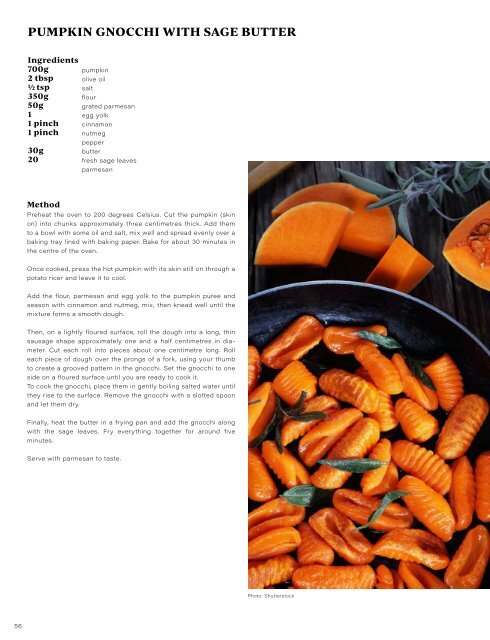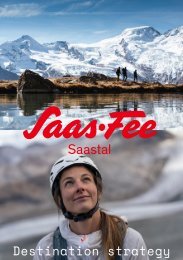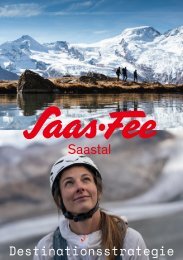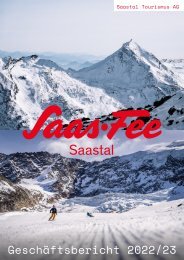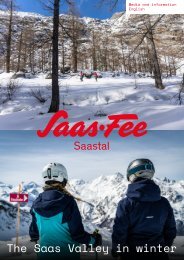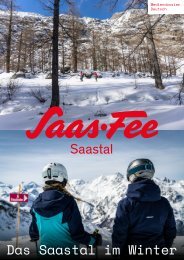Create successful ePaper yourself
Turn your PDF publications into a flip-book with our unique Google optimized e-Paper software.
PUMPKIN GNOCCHI WITH SAGE BUTTER<br />
Ingredients<br />
700g<br />
pumpkin<br />
2 tbsp olive oil<br />
½ tsp<br />
salt<br />
350g<br />
flour<br />
50g<br />
grated parmesan<br />
1 egg yolk<br />
1 pinch cinnamon<br />
1 pinch nutmeg<br />
pepper<br />
30g<br />
butter<br />
20 fresh sage leaves<br />
Method<br />
parmesan<br />
Preheat the oven to 200 degrees Celsius. Cut the pumpkin (skin<br />
on) into chunks approximately three centimetres thick. Add them<br />
to a bowl with some oil and salt, mix well and spread evenly over a<br />
baking tray lined with baking paper. Bake for about 30 minutes in<br />
the centre of the oven.<br />
Once cooked, press the hot pumpkin with its skin still on through a<br />
potato ricer and leave it to cool.<br />
Add the flour, parmesan and egg yolk to the pumpkin puree and<br />
season with cinnamon and nutmeg, mix, then knead well until the<br />
mixture forms a smooth dough.<br />
Then, on a lightly floured surface, roll the dough into a long, thin<br />
sausage shape approximately one and a half centimetres in diameter.<br />
Cut each roll into pieces about one centimetre long. Roll<br />
each piece of dough over the prongs of a fork, using your thumb<br />
to create a grooved pattern in the gnocchi. Set the gnocchi to one<br />
side on a floured surface until you are ready to cook it.<br />
To cook the gnocchi, place them in gently boiling salted water until<br />
they rise to the surface. Remove the gnocchi with a slotted spoon<br />
and let them dry.<br />
Finally, heat the butter in a frying pan and add the gnocchi along<br />
with the sage leaves. Fry everything together for around five<br />
minutes.<br />
HOW A POOR MAN’S SOUP BECAME A GOURMET CLASSIC<br />
Saas meat soup: an insider tip for gourmets.<br />
This Saas speciality has grown somewhat<br />
more luxurious than it was in the past, and<br />
even more tempting than ever.<br />
Text: Christoph Gysel<br />
Photo: Shutterstock<br />
Some dishes which have been traditionally thought of as paupers’<br />
fare have grown to become culinary classics. The most obvious<br />
local examples are Valais raclette and cheese fondue. In earlier<br />
days, when farmers returned to their alpine pastures for the summer<br />
and found dried out cheeses from the previous year in their huts,<br />
there was no way they were letting the old cheese go to waste.<br />
In these times of extreme poverty, a ‘waste not, want not’ thrift<br />
was key: nothing edible was thrown away. Even if the cheese had<br />
hardened so much that a knife wouldn’t do, even if only a hatchet<br />
would go through it. In that case, the pieces of hacked apart<br />
cheese would be placed in a pan and heated over the fire until<br />
they melted. This was where our beloved fondue originated, eaten<br />
with jacket potatoes. If the cheese simply couldn’t be chopped, the<br />
whole wheel would be held over the fire. The melting cheese could<br />
then be scraped off and eaten alongside potatoes. The result was<br />
what we now call a raclette. Born out of necessity in poorer times,<br />
these dishes became well known and loved.<br />
The history of Saaser Fleischsuppe (Saas meat soup) of the past<br />
is somewhat distant from what we enjoy today. Calling it meat soup<br />
at all back then was certainly stretching the definition of meat. The<br />
Saas folk of the past used every single part of the animals they<br />
slaughtered, even using the bones several times over. They added<br />
rock-hard bread to the ever-thinner bouillon. So hard, in fact, that<br />
it had to be chopped with a “Brothacker” (a kind of axe). Some sort<br />
of dry cheese or possibly a cheese rind followed. At times, they<br />
might also add some potatoes. The soup of the poor was filling if<br />
not much else.<br />
Today, Saaser meat soup is a speciality. It can be found in<br />
various restaurants in the Saas Valley but it’s starkly different from<br />
the old days. Today‘s gourmet chefs use high-quality bouillon, fresh,<br />
pillowy bread and delicious cheese blends. I wanted a detailed<br />
recipe for this Saas delicacy to publish in this magazine, but none<br />
of the chefs I asked would tell me theirs. Trade secret. They all<br />
admitted to using bouillon, bread, and cheese, but that was the end<br />
of the conversation.<br />
So those of you wanting to discover this traditional Saas<br />
speciality have no choice but to go out and try it for yourselves.<br />
This author would be grateful for your recommendations.<br />
Serve with parmesan to taste.<br />
Photo: Shutterstock<br />
56<br />
57


